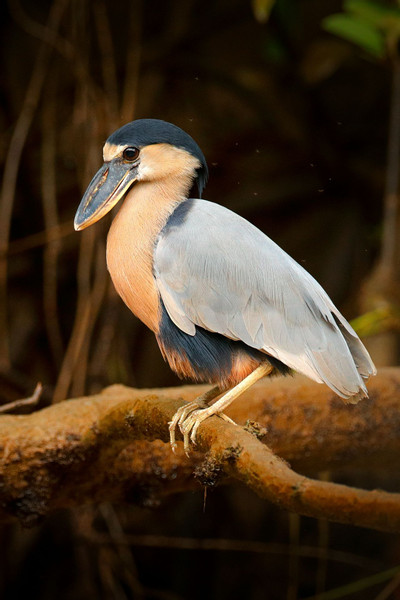The group board with great anticipation and Fidel applies the throttle and we plane across the smooth waters northwards before easing back as we turn into the muddy channels of the swamp. Our eyes are instantly drawn to a sentinel roosting tree guarding the entrance. It is adorned with red-throated Magnificent Frigatebirds and lugubrious Brown Pelicans readying themselves for a days’ fishing. An Osprey sits aloof on the neighbouring tree. What a start! We nudge up the narrowing channels with all manner of herons, egrets and waders feeding on the exposed banks and amongst the tangled roots as the tide recedes. A Snowy Egret poses, perfectly framed by a drooping branch and reflected in the still waters. Cameras click and whirr to capture the moment.
Our guides are seeking two specific species, the Boat-billed Heron for its extraordinary appearance and the Lesser Nighthawk as it is so elusive. We are not disappointed. A pair of the herons are spotted perched within the canopy with their grey capes, fawn bibs and huge flat bills and we move to within twenty feet without them taking a blind bit of notice. The Lesser Nighthawk is more difficult with its plumage making it almost impossible to see, even when its position is described to us as it lies almost flat on the branch. Once our eyes focus in, we wonder how on earth we could not see it in the first place.
The tide is falling now so we must reluctantly begin our return to the open sea but the trip continues to give. Fiddler Crabs pop out of their holes and wave their enormous and ungainly unilateral claw to attract attention. A Ringed Kingfisher works from branch to branch looking for the ideal fishing perch and a male Hoffman’s Woodpecker finishes construction of his perfectly circular hole with his yellow head and red cap a blur as he applies his finishing touches.
Fidel steers us out past the sentinel tree which now only has a single lazy late-rising pelican in residence and Fidel opens up giving us a refreshing rush of air requiring hats to be grasped before they are lost to the wake.

A week into the tour our ancestral hunter-gatherer instincts have by now been fine-tuned by Yehudi and a shout of ‘something pink to the right’ alerts our guides to the possibility of a Roseate Spoonbill. A mud bank obscures the purported position of the sighting so we swiftly perform an ‘about turn’ and gently retrace our steps. Easing past the bank we see the spoonbill in all its pink glory sifting through the glutinous soup. As we edge closer it takes off, giving us an even better impression of its stunning colouration. We pray that the images we capture will do it justice.
Even our shallow-draught vessel is now running out of navigable water so we must press on back to Ensenada and a breakfast of ‘rice and beans’, but not before an encounter with the local fishing fleet. The little double handed boats have white hulls and beautifully painted turquoise topsides. Fidel exchanges greetings with the fishermen and lets us drift slowly past them. One boat has a young girl dressed in bright scarlet trousers sitting on the foredeck. The contrasting colours and subject make for a ‘must take’ photograph and the result is quite simply my favourite of the tour. The seabirds have got wind of the hauling of the nets and flock in to pick up any scraps or discarded catch. The Magnificent Frigatebirds are first on the scene, swiftly followed by the Brown Pelicans who approach in formation like dam-buster bombers only inches from the water. The vessels are soon lost in a cloud of disputing aviators fighting for morsels thrown from the boats.
Having over-run our tour time by almost an hour Fidel hurries back to the pontoon only to find that the tide has gone out to such an extent that we have a rather undignified landing onto the barnacle- sharp beach. We care not a jot for the pain as we have had the most spectacular experience of our already stunning tour of Costa Rica.

 Loading search...
Loading search...
